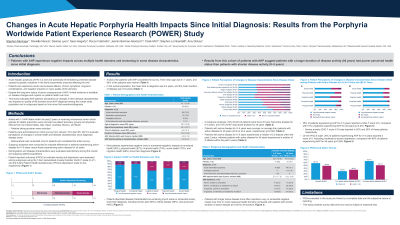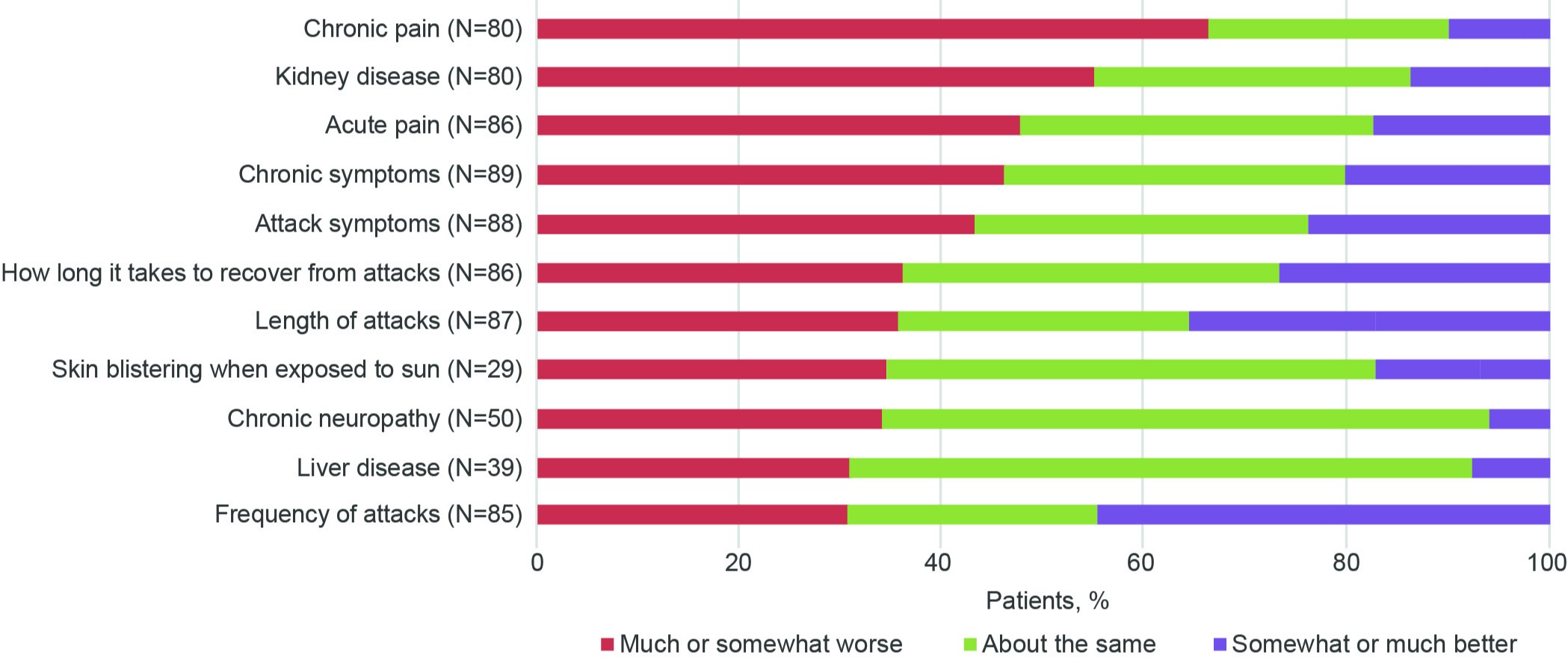Back


Poster Session D - Tuesday Morning
Category: Liver
D0486 - Changes in Acute Hepatic Porphyria Health Impacts Since Initial Diagnosis: Results From the Porphyria Worldwide Patient Experience Research (POWER) Study
Tuesday, October 25, 2022
10:00 AM – 12:00 PM ET
Location: Crown Ballroom

Has Audio

Stephen L. Meninger, PharmD, MS, MBA
Alnylam Pharmaceuticals
Cambridge, MA
Presenting Author(s)
Stephen L. Meninger, PharmD, MS, MBA1, Danielle Nance, MD2, Desiree Lyon, MS3, Sean R. Hegarty, 4, Rocco Falchetto, PhD5, Jasmin Barman-Aksözen, PhD5, Tarek Mnif, PharmD6, Stephen Lombardelli, MB, PhD7, Amy Dickey, MD, MSc8
1Alnylam Pharmaceuticals, Cambridge, MA; 2Banner Health, Gilbert, AZ; 3American Porphyria Foundation, Bethesda, MD; 4Global Porphyria Advocacy Coalition, Durham City, England, United Kingdom; 5Swiss Society for Porphyria, Zurich, Zurich, Switzerland; 6Cerner Enviza, Paris, Ile-de-France, France; 7Alnylam Pharmaceuticals, Maidenhead, England, United Kingdom; 8Massachusetts General Hospital, Boston, MA
Introduction: Acute hepatic porphyria (AHP) is caused by genetic mutations in heme biosynthetic enzymes, affecting the liver. Patients can experience acute neurovisceral attacks, chronic symptoms, long-term complications, and negative impact on many quality-of-life domains. This study evaluated patient perceptions of changes in their disease characteristics and impacts on quality-of-life domains since AHP diagnosis among the overall study population and in subgroups based on time since first symptoms/diagnosis.
Methods: Adults with > 1 AHP attack within the past 2 years or receiving intravenous hemin and/or glucose for attack prevention were administered in an online survey from January 19 to April 26, 2021. Patients taking givosiran were excluded. Subgroup analyses evaluated differences in patients experiencing active disease for 0–5 years versus ≥ 6 years. Patient-reported outcomes for anxiety and depression were assessed using the Generalized Anxiety Disorder-7 (GAD-7) scale (0–21) and the Patient Health Questionnaire (PHQ-8) scale (0–24), respectively.
Results: Of 92 patients with AHP, mean age was 41.1 years, and 90% of patients were women. Mean time to diagnosis was 6.4 years, and mean duration of disease was 16.9 years. Most patients experienced negative (very or somewhat negative) impacts on emotional health (90%), physical health (87%), financial health (75%), social health (70%), and cognitive health (66%) since diagnosis. Disease characteristics described as worsening (much worse or somewhat worse) since diagnosis, included chronic pain (66%), kidney disease (55%), and acute pain (48%) (Figure). Patients with active disease for 0–5 years (N=20, 22%) had mean age 33.9 years and experienced median 2.5 attacks in the past 2 years versus 43.4 years and 5 attacks in patients with active disease for ≥ 6 years (N=67, 73%). GAD-7 scores ≥ 10 and ≥ 15 (severe anxiety) were reported in 35% and 20%, respectively, of patients experiencing AHP for 0–5 years and in 51% and 28%, respectively, of patients experiencing AHP for ≥ 6 years. A PHQ-8 score ≥ 10, indicating moderate-to-severe depression, was reported in 30% of patients experiencing AHP for 0–5 years compared with 66% for those experiencing AHP for ≥ 6 years.
Discussion: Patients with AHP experience negative impacts across multiple health domains and worsening in some disease characteristics since initial diagnosis. Patients with longer duration of disease activity (≥ 6 years) may have poorer perceived health status than those with 0–5 years.

Disclosures:
Stephen L. Meninger, PharmD, MS, MBA1, Danielle Nance, MD2, Desiree Lyon, MS3, Sean R. Hegarty, 4, Rocco Falchetto, PhD5, Jasmin Barman-Aksözen, PhD5, Tarek Mnif, PharmD6, Stephen Lombardelli, MB, PhD7, Amy Dickey, MD, MSc8. D0486 - Changes in Acute Hepatic Porphyria Health Impacts Since Initial Diagnosis: Results From the Porphyria Worldwide Patient Experience Research (POWER) Study, ACG 2022 Annual Scientific Meeting Abstracts. Charlotte, NC: American College of Gastroenterology.
1Alnylam Pharmaceuticals, Cambridge, MA; 2Banner Health, Gilbert, AZ; 3American Porphyria Foundation, Bethesda, MD; 4Global Porphyria Advocacy Coalition, Durham City, England, United Kingdom; 5Swiss Society for Porphyria, Zurich, Zurich, Switzerland; 6Cerner Enviza, Paris, Ile-de-France, France; 7Alnylam Pharmaceuticals, Maidenhead, England, United Kingdom; 8Massachusetts General Hospital, Boston, MA
Introduction: Acute hepatic porphyria (AHP) is caused by genetic mutations in heme biosynthetic enzymes, affecting the liver. Patients can experience acute neurovisceral attacks, chronic symptoms, long-term complications, and negative impact on many quality-of-life domains. This study evaluated patient perceptions of changes in their disease characteristics and impacts on quality-of-life domains since AHP diagnosis among the overall study population and in subgroups based on time since first symptoms/diagnosis.
Methods: Adults with > 1 AHP attack within the past 2 years or receiving intravenous hemin and/or glucose for attack prevention were administered in an online survey from January 19 to April 26, 2021. Patients taking givosiran were excluded. Subgroup analyses evaluated differences in patients experiencing active disease for 0–5 years versus ≥ 6 years. Patient-reported outcomes for anxiety and depression were assessed using the Generalized Anxiety Disorder-7 (GAD-7) scale (0–21) and the Patient Health Questionnaire (PHQ-8) scale (0–24), respectively.
Results: Of 92 patients with AHP, mean age was 41.1 years, and 90% of patients were women. Mean time to diagnosis was 6.4 years, and mean duration of disease was 16.9 years. Most patients experienced negative (very or somewhat negative) impacts on emotional health (90%), physical health (87%), financial health (75%), social health (70%), and cognitive health (66%) since diagnosis. Disease characteristics described as worsening (much worse or somewhat worse) since diagnosis, included chronic pain (66%), kidney disease (55%), and acute pain (48%) (Figure). Patients with active disease for 0–5 years (N=20, 22%) had mean age 33.9 years and experienced median 2.5 attacks in the past 2 years versus 43.4 years and 5 attacks in patients with active disease for ≥ 6 years (N=67, 73%). GAD-7 scores ≥ 10 and ≥ 15 (severe anxiety) were reported in 35% and 20%, respectively, of patients experiencing AHP for 0–5 years and in 51% and 28%, respectively, of patients experiencing AHP for ≥ 6 years. A PHQ-8 score ≥ 10, indicating moderate-to-severe depression, was reported in 30% of patients experiencing AHP for 0–5 years compared with 66% for those experiencing AHP for ≥ 6 years.
Discussion: Patients with AHP experience negative impacts across multiple health domains and worsening in some disease characteristics since initial diagnosis. Patients with longer duration of disease activity (≥ 6 years) may have poorer perceived health status than those with 0–5 years.

Figure: Patient Perceptions of Changes in Disease Characteristics Since Disease Onset
Disclosures:
Stephen Meninger: Alnylam Pharmaceuticals – Employee, Stock Options.
Danielle Nance: Alnylam Pharmaceuticals – Consultant, Grant/Research Support, Speakers Bureau. Aptevo – Advisor or Review Panel Member, Advisory Committee/Board Member. BPL – Advisor or Review Panel Member, Advisory Committee/Board Member. Goval – Advisory Committee/Board Member. HemaBiologics – Advisory Committee/Board Member. Medexus – Advisory Committee/Board Member. Spark – Advisory Committee/Board Member.
Desiree Lyon: Alnylam Pharmaceuticals – Grant/Research Support.
Sean Hegarty indicated no relevant financial relationships.
Rocco Falchetto indicated no relevant financial relationships.
Jasmin Barman-Aksözen indicated no relevant financial relationships.
Tarek Mnif indicated no relevant financial relationships.
Stephen Lombardelli: Alnylam Pharmaceuticals – Employee, Stock Options.
Amy Dickey: Alnylam Pharmaceuticals – Advisory Committee/Board Member, Consultant, Travel costs to conferences.
Stephen L. Meninger, PharmD, MS, MBA1, Danielle Nance, MD2, Desiree Lyon, MS3, Sean R. Hegarty, 4, Rocco Falchetto, PhD5, Jasmin Barman-Aksözen, PhD5, Tarek Mnif, PharmD6, Stephen Lombardelli, MB, PhD7, Amy Dickey, MD, MSc8. D0486 - Changes in Acute Hepatic Porphyria Health Impacts Since Initial Diagnosis: Results From the Porphyria Worldwide Patient Experience Research (POWER) Study, ACG 2022 Annual Scientific Meeting Abstracts. Charlotte, NC: American College of Gastroenterology.
